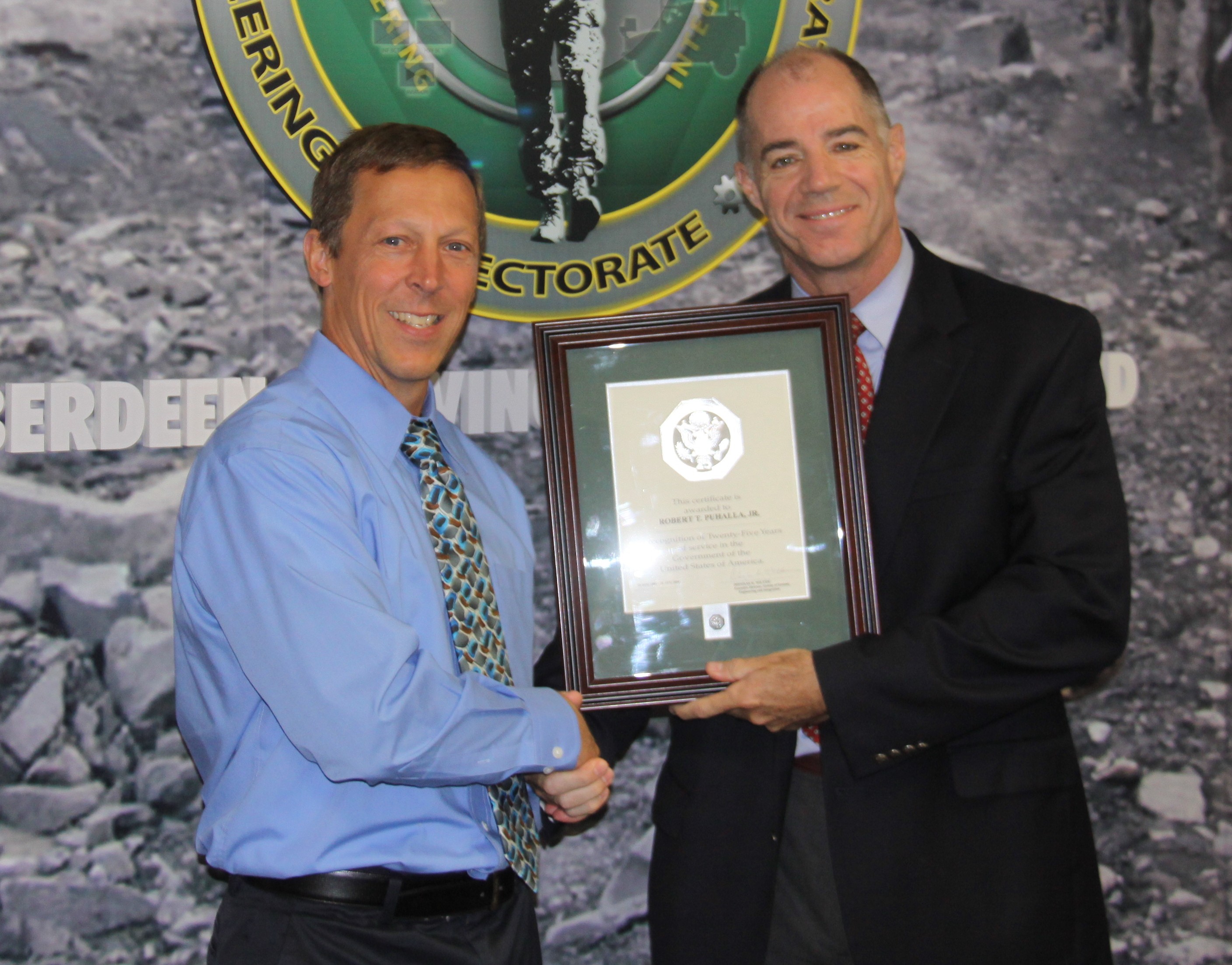
COMMAND/ORGANIZATION: Synchronized Fielding Division, System of Systems Engineering and Integration Directorate, Assistant Secretary of the Army for Acquisition, Logistics and Technology
TITLE: Chief engineer
YEARS OF SERVICE IN WORKFORCE: 25
DAWIA CERTIFICATIONS: Level III in science and technology management; Level III in test and evaluation
EDUCATION: M.S. in mechanical engineering, Drexel University; B.S. in aerospace engineering, Pennsylvania State University
AWARDS: Superior Civilian Service Award; Baltimore Federal Executive Board Excellence in Government Award
Get your hands dirty
By Ms. Susan L. Follett
Want to do your job more effectively? Consider Robert Puhalla’s advice: Go talk to the people you work with and work for. “A lot of us now have amazing access to information just sitting at computers at our desks,” said Puhalla, chief engineer in the Synchronized Fielding Division of the System of Systems Engineering and Integration (SoSE&I) Directorate. “But you have to get away from your desk, go work with the folks in the labs, get out to the field and experience things hands-on. There’s no replacing that, even today. You don’t understand the angle of the user unless you get out to the field and see how this stuff works, the goods and bads. Hear the Soldiers talk, hear the technicians talk, go through there and get your hands dirty. It’s maybe a little cliché, but it’s easy not to do.”
The goal of synchronized fielding is to integrate tactical communication systems—including voice, video, text and data—in a smarter fashion, so that the Army is not fielding these technologies to units individually but as a package that delivers a holistic operational effect. Puhalla’s job is to bring all of the different systems and organizations together to support capability set fieldings to infantry, Stryker and eventually armored brigade combat teams (BCTs).
“We work with the network and platform project managers (PMs), the Army G-staff, and TRADOC capability managers (TCMs) to ensure that each fielding answers requirements and user needs in an integrated manner,” he said. “When we’re successful, we avoid having to touch that unit multiple times, which not only makes sense from a technical, system-of-systems engineering perspective, but also reduces the Soldiers’ training time for these critical capabilities.” Puhalla and his team also work on modernization plans, “such as how we integrate the network onto the heavy platforms for Armor BCTs, which have a much longer lead time for engineering and test,” he said.
For Puhalla, his greatest satisfaction comes from earning the trust of the PMs to identify and address system of systems issues before they get to the unit. “Early in the synchronized fielding process, just before the Army delivered the first capability set to two 10th Mountain Division BCTs that were about to deploy to Afghanistan with the equipment, we held an integration event at Fort Dix that identified several issues that we could fix in real time or quickly thereafter, so we could roll them into the final product before it went downrange. It felt good to help with the solution.”

Robert Puhalla, left, received a certificate recognizing 25 years of federal service from Doug Wiltsie, Executive Director, ASA(ALT) System of Systems Engineering and Integration Directorate, at Aberdeen Proving Ground, Md., in July 2016. (Photo by Claire Heininger, ASA(ALT) SoSE&I)
Puhalla joined the Army Acquisition Workforce as a member of the U.S. Army Test and Evaluation Command (ATEC) in 2001, but his federal career dates back to 1989, when he worked in aerodynamics testing for the Ballistic Research Laboratory (BRL) at Aberdeen Proving Ground, Maryland. One of his first bosses was Robert L. McCoy, a well-known and published expert in ballistics.
“He was smart as a whip, and he was also a West Virginia good ol’ boy who had much practical experience. So he was able to teach me not only the technical side of our work, but also the commonsense and human side of it,” said Puhalla. “He would say, ‘Don’t try to design a fancy solution when a simple one will do. Be practical about your approach.’ So that doesn’t mean you don’t have to think hard and work hard, but always keep in mind that practical side about what you’re doing here, even in a highly technical field. Nearly 25 years later, those words have stayed with me.”
BRL was absorbed by the U.S. Army Research Laboratory in 1992, and Puhalla’s branch, Firing Tables and Aeroballistics, moved to the U.S. Army Armament Research, Development and Engineering Center (ARDEC) in Picatinny, New Jersey. He left ARDEC in 1999 and worked for a contractor for a few years before returning to ATEC. “When I came back with ATEC, I was evaluating a weapon system for a helicopter. I worked with the PM shop and the TCMs to do a fair evaluation early on in the program, which was rewarding because it helped guide decisions based on what was working well and not working well through the eyes of the user.”
He moved within ATEC to support testing for the Future Combat Systems (FCS) program in 2004, and joined the program management side of FCS in 2008. After the program was canceled, the integration and synchronized fielding mission eventually evolved to SoSE&I. “I’ve been pretty fortunate in my career. I’ve been able to have a wide experience, from analysis, to test, to PM, to the requirements on the Soldier side, even the contract side, where I had to worry about bringing in money for the contract. It’s good to have those broadening experiences.”
Puhalla continues to amass those broadening experiences with SoSE&I, which is part of the Office of the Assistant Secretary of the Army for Acquisition, Logistics and Technology (ASA(ALT)). “Working at the ASA(ALT) headquarters level “gives me a better understanding of how the Army works from A to Z,” Puhalla noted. “You don’t have your PM hat on all the time, you don’t have your TCM hat on all the time. You’re a broker, so you try to help with those kinds of talks and negotiations and provide a fair evaluation of which position wins out for any particular day.”
Looking back over his career, he added, “One thing I do wish I had pursued is the Army War College or a similar program. I think there’s a lot of benefit in seeing the strategic side of how big Army works, and even with ASA(ALT) there is a limited set of goggles and lenses that we look through. Those kinds of training opportunities serve you well—even if you’re not intending to be part of the Senior Executive Service—because they help you understand the big Army and why we do and don’t do certain things.”
He has one last piece of advice. “Follow through with your relevant training, both in your area of expertise and some outside your area of expertise. Your training should help broaden your perspective and your views. Finally, prioritize: make sure you know what’s important and what has to be done. We’re all given the same amount of time; it’s up to you how you choose to spend it.”
This article was originally published in the October – December 2016 issue of Army AL&T magazine.
“Faces of the Force” highlights members of the Army Acquisition Workforce through the power of individual stories. The series, produced by the U.S. Army Acquisition Support Center Communication and Support Branch in close coordination with public affairs officers, features Soldiers and DA civilians serving in a variety of AL&T disciplines. For more information, or to nominate someone, go to https://asc.army.mil/web/publications/army-alt-submissions/.
Subscribe to Army AL&T News, the premier online news source for the Acquisition, Logistics, and Technology (AL&T) Workforce.







